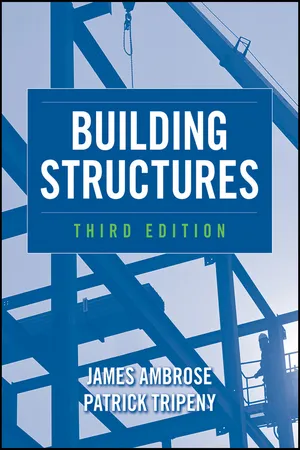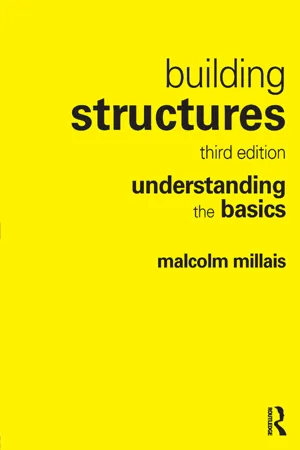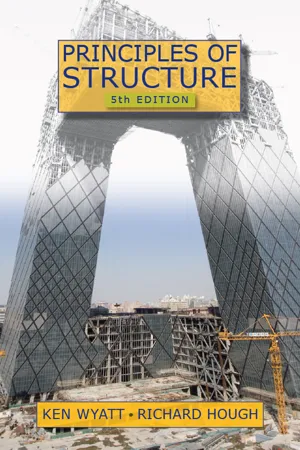Technology & Engineering
Internal Forces
Internal forces refer to the forces that act within a structure or object. These forces include tension, compression, and shear, and they are essential for understanding how materials and structures behave under different conditions. By analyzing internal forces, engineers can design and construct buildings, bridges, and other structures to ensure they can withstand the forces they will encounter.
Written by Perlego with AI-assistance
Related key terms
Related key terms
1 of 4
Related key terms
1 of 3
4 Key excerpts on "Internal Forces"
- eBook - ePub
- James Ambrose, Patrick Tripeny(Authors)
- 2011(Publication Date)
- Wiley(Publisher)
Although stresses and strains result from the actions of external forces, we visualize them directly as the products of internal force actions. Thus the individual actions of tension, compression, shear, bending, and torsion are each visualized as the manifestations of a characteristic set of internal stresses and strains in the material of the structure. The free-body diagram and the cut section are essential tools for these visualizations.At any particular location within a structure under load there is usually not a single internal force action, but rather some combination of actions. Consider the actions of the simple, axially loaded column and the simple tension rod as shown in Figures 2.24 a and b . In these the internal force actions can be visualized in the form of simple, single effects of compression or tension.Figure 2.24 Development of Internal Forces.We do indeed make use of such simple elements on some occasions but more often need to consider more complex actions. For example, for the vertical support for the sign shown in Figure 2.24 c , the internal actions developed by a combination of gravity plus wind include compression, shear, torsion, and two-way bending. These occur all at once, so a true analysis must somehow combine all the effects into some net stressed and strained condition.Although true service conditions must be considered for a realistic design, it is the usual practice to visualize and analyze for individual internal actions separately. This is not necessary for the computer, but most human beings find it more feasible to handle individual actions one at a time before attempting to visualize their net effect. For initial study in particular, we will follow this procedure of divide and conquer in the following sections, before considering combined and net effects.Stress and StrainStress is not truly one dimensional or two dimensional; it is always three dimensional, as is the shape change in the three-dimensional material that experiences the stress. This idea was discussed and illustrated in Chapter 1, and it is important to keep the true nature of stress and strain in mind. For purposes of computation in investigation and design work, however, we routinely make determinations of some simplified stress conditions. These are not done as the true representations of the complete stress and strain actions, but simply as indicators of general conditions. - eBook - ePub
Building Structures
understanding the basics
- Malcolm Millais(Author)
- 2017(Publication Date)
- Routledge(Publisher)
CHAPTER 2 Internal ForcesSo far, loads, reactions and load paths have been identified for structures. But how does the structure transfer the load to the reaction? And what happens to the structure when it transfers loads? The structure transfers loads by forces that are in the structure and these forces cause stresses in the structural material. The structure also deforms under the effect of the loads, and the size of the deformation depends on the stiffness of the structure.2.1 Axial forces
To illustrate the idea of internal force consider a simple column supporting an end load.Fig.2.1What happens to a typical slice of the column?Fig.2.2The slice is being squashed, or compressed, and furthermore all slices are being squashed.Fig.2.3The column transfers the end load to the reaction by a system of ‘squashed slices’, or to use the engineering description, the column is in compression.Fig.2.4Not only is the column in compression but also deforms by shortening. This happens because each slice becomes thinner on being squashed.Fig.2.5If the direction of the load is reversed then each slice is being stretched, and the end load is transferred to the reaction by a system of ‘stretched slices’. Or, to use the engineering term, the column is in tension.Fig.2.6Forces that stretch or compress elements in the direction of their longitudinal axis are called axial forces and these always act along the element.2.2 Bending moments and shear forces
Looking again at the load path for load P6 (see Fig. 1.61 ), the walls supporting the upper beam are in compression.Fig.2.7But what is happening to the upper and lower beams? These beams are transferring the loads to the supports by a combination of bending moments and shear forces - eBook - ePub
- Ken Wyatt, Richard Hough(Authors)
- 2013(Publication Date)
- CRC Press(Publisher)
Compressive stress, which is present when the material shortens or compresses. The average compressive stress is also found by dividing the internal compressive force by the cross-sectional area.(c) Shear stress, which is present when the material undergoes angular distortions. The average shear stress is calculated by dividing an internal force by an area parallel to that force.CONTENT OF CHAPTER 2In order to make sure that our structures have enough strength to withstand the external forces that will be applied to them during their lifetimes, we need to be able to predict and measure the effects of those forces. In this chapter, we study the stress and the strain that occur in a structure when external forces are applied, and see how structural safety can be achieved by limiting these stresses. We will apply these techniques to the design of simple tension and compression structures.2.1 PRESSURE
In paragraph 1.12 we saw that loadings are often applied to structures in the form of pressures. Quite often the applied force, instead of being concentrated at a single point, is distributed over a finite area.When a force is distributed over part of the external surface of a structure, it is referred to as a pressure. Pressure is defined as force per unit area:Pressure (P) =total external forcesurface area over which force actsIn the study of structural behaviour, we use the term pressure when we are discussing forces at the interface between two materials. The pressure of water against the wall or floor of a pool, the pressure of the wind on the wall of a building, the pressure between a heap of sand and the floor — these are all common examples of pressures applied to the surface of some object (Figure 2.1 ). We will use the term pressure when we are referring to an external force distributed over an area at the surface of an object.FIGURE 2.1EXAMPLE 2.1A brickwork pier carries a vertical axial load of 60 kN and is supported on a concrete footing. What are the stresses within the brickwork, and the pressures on the upper and lower surfaces of the footing? - eBook - ePub
Practical Guide to the Packaging of Electronics
Thermal and Mechanical Design and Analysis, Third Edition
- Ali Jamnia(Author)
- 2016(Publication Date)
- CRC Press(Publisher)
11 Mechanical and Thermomechanical ConcernsIntroduction
An important aspect of electronics packaging is developing an understanding of the stresses that its components undergo and their relationship to the system’s failure and/or reliability. The cause of these stresses may be temperature and its variations, vibration, or physical properties such as weight. It may occur at the board and component level, enclosure levels, and up to the system itself.Stresses are internal distributed forces, which are caused by external applied loads. Strains are changes in the form under the same loads. Consider a rod of length L and diameter A . One may intuitively recognize that the displacement of the end of this rod depends directly on the magnitude of the applied force—very similar to the force–deflection relationship of a spring–mass system as shown in Figure 11.1 .Now consider what happens inside of this rod in Figure 11.2 . The concentrated load is (internally) developed over the area of the cross section. Thus, one may express this distributed force as follows:
Similarly, a distributed (average) displacement may also be calculated.σ =F Aε =Δ LIt turns out that σ and ε have a relationship similar to a force–deflection curve in a spring–mass system. The slope of this line (E ) is called tensile modulus, Young’s modulus, or modulus of elasticity.Figure 11.1 Force–deflection relationship.Consider another scenario. A block under a shear force will also deflect. In shear, the force–deflection relationships are defined as follows:Figure 11.2 Internal Forces.F = τAwhere A is the area and τ is the shear stress. Furthermore, there is a relationship between the shear stress and shear strain (γ) similar to that of the stress–strain relationship.τ = G γwhere G is shear modulus and γ is shear strain.In general, both normal and shear stresses develop in solids under a general loading. For example, a cantilever beam under a simple load at the free end exhibits both normal and shear stresses, as shown in Figure 11.3
Index pages curate the most relevant extracts from our library of academic textbooks. They’ve been created using an in-house natural language model (NLM), each adding context and meaning to key research topics.
Explore more topic indexes
Explore more topic indexes
1 of 6
Explore more topic indexes
1 of 4



